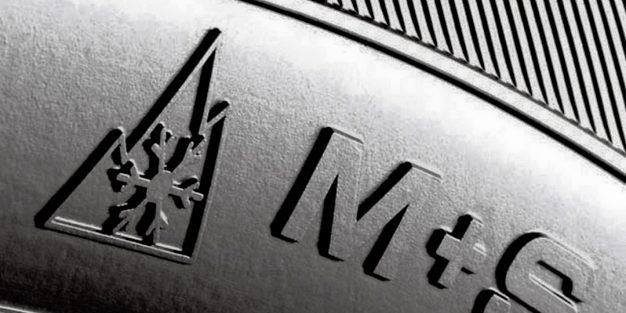If you live somewhere north of the Mason-Dixon line, cold weather is an annual reality. And in places like our home state of Michigan, the beginning of fall often means thinking about getting one’s car (or in our case, our long-term test fleet) ready for snow, i.e., new winter tires. But not everyone switches to dedicated winter rubber in the cold months, instead relying on all-season tires to get through snow, ice, slush, and just plain cold weather. Fortunately for those folks, in the last couple of years a new subset of all-seasons has emerged: the “all-weather” tire.
What denotes an all-weather tire versus an all-season one is a small pictogram on the sidewall known as the three-peak mountain snowflake (3PMSF), pictured above. This symbol is a seal of approval of sorts that indicates the tire has been tested and it is capable of at least 110 percent of the traction of a reference all-season tire (for the nerds, the standard is ASTM E1136-14). Yeah, it is vague, but it is a laboratory test that actually tells consumers more than an M+S marking (also seen above), which is just a calculation of tread geometry.
All-Weather Tires Include the 3PMSF
All dedicated winter tires have the 3PMSF, but an all-weather tire is suitable for winter conditions yet doesn’t necessarily have to be swapped on and off every winter and spring. This is ideal for some markets where winter tire use is compulsory, like Quebec and many northern European countries. For what it’s worth, the only all-season tires you can find in Europe are these all-weather tires.
One of the more popular all-weather tires for cars and SUVs in the United States in recent years is the Michelin CrossClimate2. They offer a six-year/60,000-mile treadwear warranty, making the warranty competitive with even some non-3PMSF all-seasons. Tire warranty is one of the most important factors consumers should consider when buying replacement rubber. As a general rule, winter tires don’t come with a treadwear warranty, though most all-weather tires will.
The rubber compounds used for dedicated winter tires are not designed for warm weather and will wear at elevated levels when driven above certain temperatures. Also, wet traction and cold traction are what the industry calls a target conflict, meaning that if you want wet grip you must give up cold grip and vice versa. Getting a 3PMSF tire to return decent wet grip while not wearing like balsa wood under 100-grit sandpaper was a eureka moment for the tire industry. Just as tires have improved their performance in the dry, they have also improved in snow and ice. That, along with rubber performing its task at a wider temperature range, has allowed some tire manufacturers to make a tire that consumers can run year-round but that can still be approved for places like Quebec.
Every Tire Needs the Right Balance
The light-truck tire category is generally excluded from the all-weather tire conversation—though many LT tires are 3PMSF certified. We have included a complete list of the various year-round, “all-weather” passenger tires on sale or nearly on sale in our market. The penetration of the 3PMSF symbol has been slower in the passenger-car category, even though there are many tires that may qualify for the marking.
The 3PMSF initially was created and reserved for winter tires. “Every tire needs the right balance of three things to work in those conditions—proper tread pattern, appropriate tread compound, and sufficient tread depth. This is true for a racing slick, true for an M/T tire slogging through mud, and true for any tire driving in the snow,” according to Woody Rogers, Tire Rack’s director of tire information. And while that balance is swinging wider than ever before, not everyone will be happy with the performance of a 3PMSF all-season tire.
If you need true cold-weather, slush-cutting, black-ice-gripping winter tires, stick with those that you need to swap on and off. If you’re in, say, the Cincinnati-to-Nashville latitude and short-lasting winter squalls occasionally threaten to leave you stranded, the all-weather tire is a one-tire solution that might be worth looking into. Odds are that, in the future, more and more all-season tires will get the 3PMSF symbol while still maintaining a competitive warranty.
3PMSF passenger-car tires:
Michelin CrossClimate2
Bridgestone WeatherPeak
Goodyear Assurance WeatherReady
Firestone WeatherGrip
Nokian WRG4
Yokohama Geolander CV4S
General Altimax 365AW
Hankook Kinergy 4S2
Falcon Aklimate
Toyo Celsius II
Kenda Vezda Touring 4S
Pirelli WeatherActive Line
Vredestein Quatrac
Executive Editor
K.C. Colwell is Car and Driver’s executive editor, who covers new cars and technology with a keen eye for automotive nonsense and with what he considers to be great car sense, which is a humblebrag. On his first day at C/D in 2004, he was given the keys to a Porsche 911 by someone who didn’t even know if he had a driver’s license. He also is one of the drivers who set fast laps at C/D‘s annual Lightning Lap track test.

